Ad
The kinds of features you need from your spreadsheet application can vary, though many users never come close to needing the robust features of Microsoft 365’s Excel.
If you aren’t an accountant crunching numbers daily, Microsoft 365, including Excel, can be prohibitively expensive. You’re looking at paying at least $6 per month for one business license, paid in full for a year upfront; $6.99 a month for home use; or $159.99 for an Office Home and Student 2021 license.
SEE: Explore free alternatives to Microsoft Word.
If you don’t have that kind of money, don’t need all of Excel’s features, or simply want to save cash, there are plenty of viable alternatives to Microsoft Excel available in the cloud to be installed on your computer. Best of all, these alternatives to Excel are free.
1
Pipedrive CRM
Company Size
Employees per Company Size
Micro (0-49), Small (50-249), Medium (250-999), Large (1,000-4,999), Enterprise (5,000+)
Any Company Size
Any Company Size
Features
24/7 Customer Support, Analytics / Reports, API, and more
2
CrankWheel
Company Size
Employees per Company Size
Micro (0-49), Small (50-249), Medium (250-999), Large (1,000-4,999), Enterprise (5,000+)
Any Company Size
Any Company Size
Features
Analytics / Reports, API, Dashboard, and more
Top free Excel alternative programs compared
My ratingStarting paid cost*Online collaborationOffline editingMobile app
Google Sheets4.82/5$7/user/monthYesLimitedYes
Microsoft 365 Excel Online4.6/5$8.25/user/monthYesNoYes
Zoho Sheet4.56/5N/AYesLimitedYes
ClickUp4.54/5$7/user/monthYesNoYes
WPS Spreadsheet4.5/5$2.99/user/monthLimitedYesYes
Smartsheet4.41/5$9/user/monthYesLimitedYes
Apple Numbers4.4/5N/AYesYesYes
LibreOffice Calc4.1/5N/ANoYesNo
Airtable4.08/5$20/user/monthYesNoYes
Gnumeric4/5N/ANoYesNo
Apache OpenOffice Calc3.92/5N/ANoYesNo
*With annual billing. Month-to-month prices are also available at a higher rate, unless otherwise specified.
Google Sheets: Best overall for offline editing and collaboration
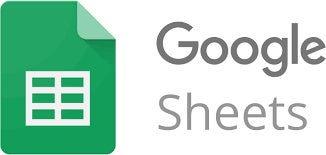 Image: Google
Image: Google
Overall rating: 4.82/5
Cost: 4.94/5
Core features: 4.93/5
Ease of use: 5/5
Support: 4.38/5
Expert score: 4.69/5
Google Sheets is Google’s cloud-based answer to Microsoft Excel, and it can do the vast majority of what the average Excel user needs. It’s part of the Google Workspace suite of apps, so you never have to worry about losing a calculation because it saves everything in Google Drive.
It’s also hosted in the cloud and runs in a web browser, so it’s platform-independent and can be run on Windows, macOS, and Linux systems. Plus, it supports pivot tables, data validation, charts, custom automation, and offline editing.
Why I chose Google Sheets
As a long-time Google Sheets user, I can strongly vouch for it. Google Sheets fills my need for a cloud-based spreadsheet that could handle real-time collaboration with my remote team. The ability to edit simultaneously, leave comments, and track version history has made my workflows smoother.
I also love that I can access my files from any device and use Google Apps Script to automate repetitive tasks. This free Excel replacement strikes the perfect balance between power and simplicity without costing me a dime.
Pricing
- Essentials Starter: $0 for one user. It has 15GB of Google Drive storage and access to Google Workspace apps, including Sheets, Docs, Calendar, Meet, Chat, and Slides.
- Business Starter: $7 per user per month, billed annually ($8.40 per user per month, billed monthly). This includes 30GB of Google Drive storage, a custom business email, a Gemini AI assistant, and up to 100 participants in video meetings.
- Business Standard: $14 per user per month, billed annually ($16.80 per user per month, billed monthly). This includes everything in the Business Starter plan, plus 2TB of Google Drive storage, e-signature with Docs and PDF, an AI research assistant, and 150 participants in video meetings.
- Business Plus: $22 per user per month, billed annually ($26.40 per user per month, billed monthly). This includes everything in the Business Standard plan, 5TB of Google Drive storage, enhanced security, and 500 participants in video meetings.
- Business Enterprise: Contact the provider for a custom quote. This plan includes everything in the Business Plus plan, enhanced support, and 1,000 participants in video meetings.
Key features
- Offline editing capability.
- Support of file formats, including .xlsx, .xls, .xlsm, .xlt, .xltx, .xltxm, .ods, .csv, and .tsv.
- Data analysis and visualization.
- Sharing and collaboration.
- Version history feature lets you see all the changes you and others have made to the spreadsheet or revert to previous versions.
- Template gallery.
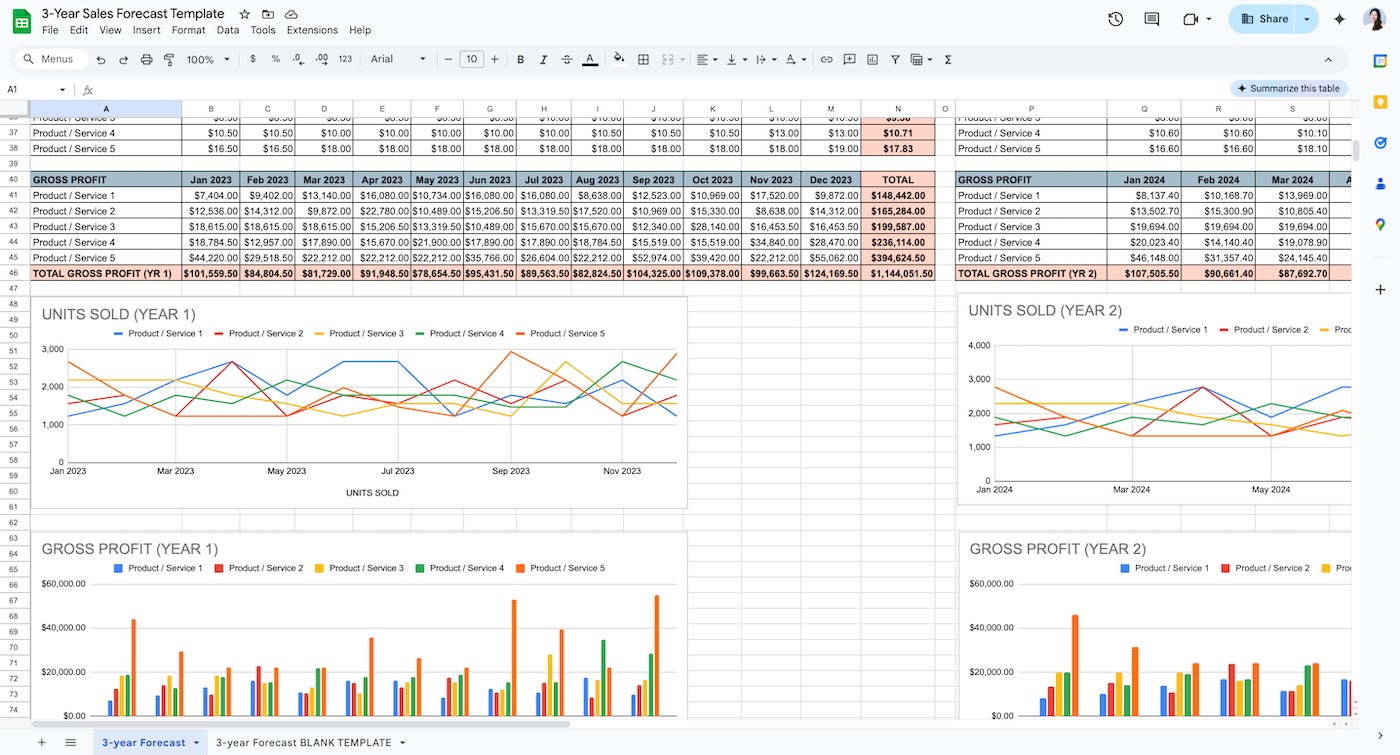 Google Sheets example table with data visualization. Image: Google Sheets
Google Sheets example table with data visualization. Image: Google Sheets
Pros and cons
ProsCons
- Excellent real-time collaboration.
- Native integration with Google Workspace tools, including Drive, Calendar, and Docs.
- Google Apps Script for custom automation.
- Limited offline functionality.
- Slower with large or complex datasets.
- Lacks advanced features found in desktop Excel, such as LAMBDA formula support and a waterfall chart.
Microsoft 365 Excel Online: Best for Microsoft Office 365 users with light spreadsheet needs
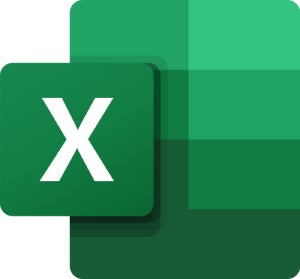 Image: Microsoft
Image: Microsoft
Overall rating: 4.6/5
Cost: 5/5
Core features: 4.69/5
Ease of use: 4.06/5
Support: 4.38/5
Expert score: 4.44/5
Microsoft 365 Excel Online is a streamlined, browser-based version of Excel designed for users who need basic spreadsheet capabilities without the full desktop suite. It’s ideal for Office 365 subscribers who want familiar Excel functionality, including charts, formulas, and conditional formatting, in a collaborative, web-based environment.
While it lacks advanced features like macros or complex data modeling, its native integration with OneDrive, Teams, and SharePoint makes it a practical choice for light spreadsheet tasks within Microsoft-centric organizations.
Why I chose Microsoft 365 Excel Online
Excel Online includes many of the same features as the desktop version of Excel, such as formulas, charts, and formatting options. Since I already use Office 365 for my personal documents, this alternative for Excel for the web gives me just what I need for quick spreadsheet edits without installing anything.
It’s familiar, reliable, and syncs perfectly with OneDrive and Microsoft Teams. While it’s not as full-featured as desktop Excel, it’s ideal for managing budgets, schedules, and shared documents on the go.
Pricing
- Free: This plan is free for one user and includes 5GB of cloud storage and access to web and mobile versions of Microsoft Excel, Word, PowerPoint, OneDrive, and Outlook.
- Microsoft 365 Business Basic: $4.75 per user per month, billed annually ($5.70 per user per month, billed monthly). This includes everything in the free plan, with 1TB cloud storage, a custom business email, and over 10 additional apps, including Microsoft Planner and Forms.
- Microsoft 365 Business Standard: $10.25 per user per month, billed annually ($12.30 per user per month, billed monthly). This includes everything in the Microsoft 365 Business Basic plan, collaborative workspaces, and video editing and design tools.
- Microsoft 365 Business Premium: $19.75 per user per month, billed annually ($23.70 per user per month, billed monthly). This includes everything in the Microsoft 365 Business Standard plan, advanced identity and access management, and enhanced cyberthreat protection.
Key features
- Power BI integration.
- Support of many file formats, including .docm, .docx, .pptm, .pptx, .xlsm, and .xlsx.
- Copilot in Excel, which works with you to analyze and explore your data.
- Ability for users to visualize data in charts and graphs.
 Microsoft 365 Excel Online table tools. Image: Microsoft
Microsoft 365 Excel Online table tools. Image: Microsoft
Pros and cons
ProsCons
- An extensive range of functions and formulas enables users to perform complex calculations and data analysis easily.
- Familiar Excel interface.
- Collaboration capability.
- Gets slow when working with large data sets.
- Requires a Microsoft account.
- No offline mode.
Zoho Sheet: Best for workflow automations
 Image: Zoho
Image: Zoho
Overall rating: 4.56/5
Cost: 5/5
Core features: 4.86/5
Ease of use: 4.06/5
Support: 3.94/5
Expert score: 4.31/5
Zoho Sheet is a powerful online spreadsheet platform that goes beyond number crunching by enabling workflow automations, data validation, and advanced functions. Collaborators can use data cleaning to catch mistakes quickly or roll back to a previous iteration with version history. Additionally, you can easily use Zoho Sheet via the mobile app or the web with granular controls over embedded data manipulation.
Why I chose Zoho Sheet
Zoho Sheet stood out to me for its advanced features and extensive automation capabilities. I especially like its data cleaning and AI-powered analysis. This would be my choice if I needed a free software like Excel that could handle complex formulas while also letting me automate routine data workflows. Its integration with Zoho CRM and other Zoho apps like CRM and Projects helps centralize everything I manage.
Pricing
Zoho Sheet is completely free for individuals and small teams. There are currently no standalone paid plans for Zoho Sheet, but it’s bundled with several other paid Zoho products, such as Zoho Workplace (for communication and collaboration) and Zoho One (for business operations).
Key features
- Multi-language support, including Polish, Bulgarian, Dutch, Chinese (Simplified), German, English, Spanish, French, Croatian, Turkish, Japanese, Hungarian, Korean, Portuguese, Russian, Swedish, and Italian.
- Support for over 350 predefined functions.
- Users can export .html and .pdf formats.
- Custom and user-defined functions.
- Image-to-sheet feature allows users to scan books, receipts, and invoices and automatically convert them to spreadsheets.
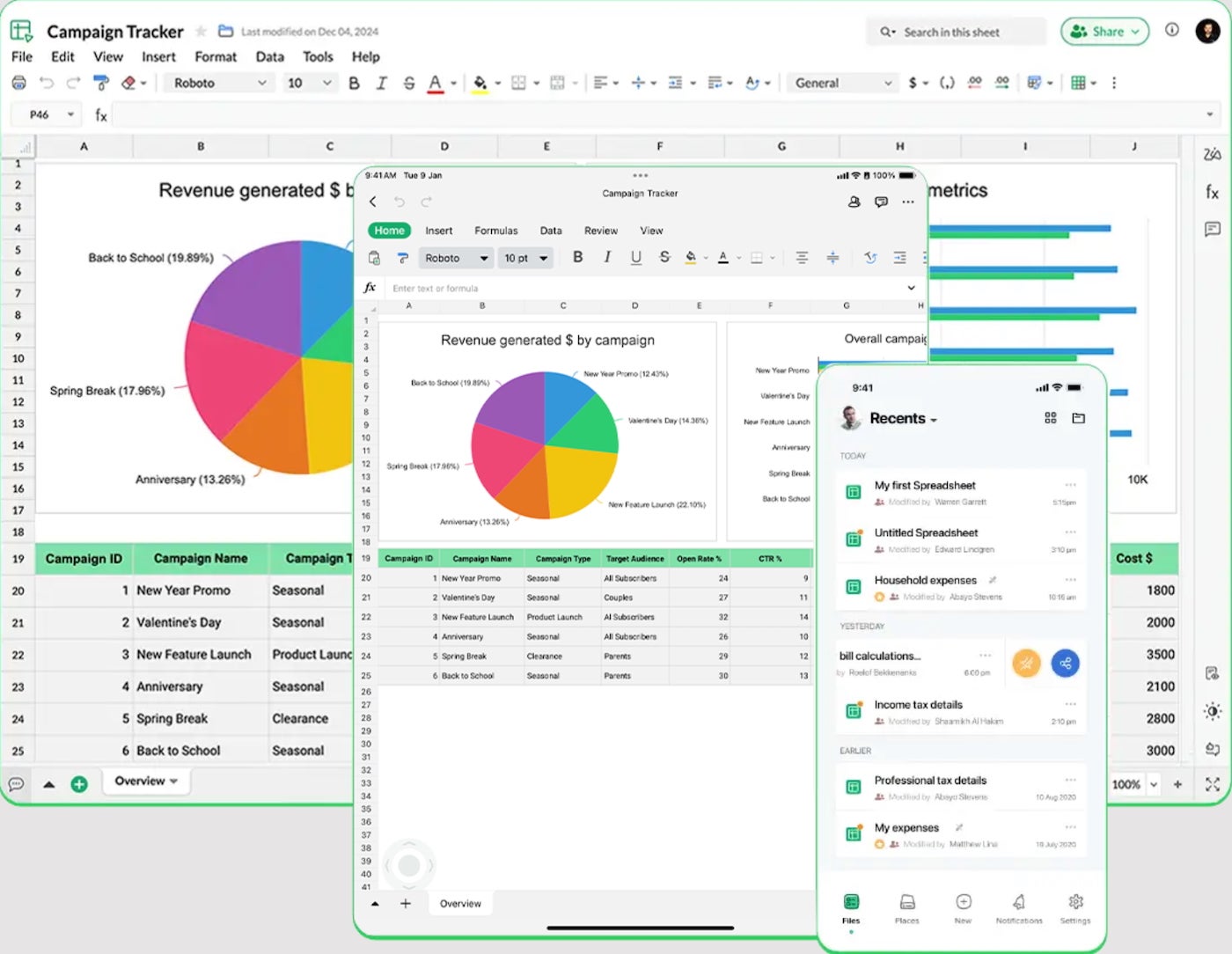 Zoho Sheet online spreadsheet interface is seen on various devices. Image: Zoho Sheet
Zoho Sheet online spreadsheet interface is seen on various devices. Image: Zoho Sheet
Pros and cons
ProsCons
- Workflow automation features.
- AI-powered insights.
- Data cleaning for duplicates, inconsistencies, and missing value removal.
- Lacks data connections, analysis, and modeling capability.
- Lacks offline support.
- Slight learning curve for advanced features.
ClickUp: Best for agile teams with spreadsheet-style task tracking
Overall rating: 4.54/5
 Image: ClickUp
Image: ClickUp
Cost: 4.75/5
Core features: 4.76/5
Ease of use: 3.75/5
Support: 4.38/5
Expert score: 4.69/5
ClickUp isn’t a traditional spreadsheet tool, but its Table View offers a flexible, spreadsheet-like interface for tracking tasks, managing workflows, and visualizing project data. Agile teams can organize projects using custom fields, statuses, priorities, and dependencies within a grid format familiar to spreadsheet users.
This platform also offers powerful integrations, real-time collaboration, and multiple project views, including Gantt, Kanban, and calendar, making it ideal for operations management.
Why I chose ClickUp
ClickUp is not just a spreadsheet replacement; it’s a total workflow system that I can use to keep my entire project on track. I’m not particularly fond of its steep learning curve, which typically comes with a platform as robust as ClickUp.
However, I love how familiar its Table View feels and how I can easily toggle between lists, calendars, and Gantt charts. This is a flexible platform that allows me to manage tasks like I do in spreadsheets, but with more structure and visibility.
Pricing
- Free Forever: $0 for unlimited users and 100MB storage. This plan includes unlimited tasks, collaborative docs, whiteboards, Kanban boards, sprint management, and calendar view.
- Unlimited: $7 per user per month, billed annually ($10 per user per month, billed monthly). This includes everything in the Free Forever plan, plus column calculations and unlimited storage, integrations, dashboards, Gantt charts, custom fields, and chat messages.
- Business: $12 per user per month, billed annually ($19 per user per month, billed monthly). This includes everything in the Unlimited plan, plus unlimited teams, advanced automations, timelines, mind maps, and timesheets.
- Enterprise: Contact the provider for a custom quote. This includes everything in the Business plan, plus white labeling, conditional logic in forms, advanced permissions, and default personal views.
Key features
- Table View for spreadsheet-style task management.
- Custom fields and column configuration.
- Multiple view options, including Kanban, calendar, Gantt, list, and timeline.
- Ability to automate routine actions and set task dependencies.
- Collaboration and real-time updates with comments, mentions, and document sharing.
 ClickUp Table View of the task management system. Image: ClickUp
ClickUp Table View of the task management system. Image: ClickUp
Pros and cons
ProsCons
- Multiple views include Gantt, Kanban, and calendar.
- Supports project workflows and dependencies.
- Real-time updates and collaboration.
- Not a traditional spreadsheet tool.
- Lacks advanced calculation or formula support.
- Steep learning curve for data-centric tasks.
WPS Spreadsheet: Best offline spreadsheet for individual users
 Image: WPS
Image: WPS
Overall rating: 4.5/5
Cost: 4.88/5
Core features: 4.28/5
Ease of use: 4.69/5
Support: 4.69/5
Expert score: 3.75/5
WPS Spreadsheet is highly capable, free software similar to Excel that delivers a robust offline experience. Ideal for individuals who require advanced functions such as pivot tables, charts, and macro-like scripting, WPS offers a familiar feel without the Microsoft price tag.
It’s lightweight and fast, supporting a wide range of Excel file types while providing enough features to handle most personal and professional spreadsheet needs, especially when internet access is limited or inconsistent.
Why I chose WPS Spreadsheet
When it comes to robust features that are a true competition for Excel, WPS Spreadsheets can’t be beaten, and for good reason: It’s the only freemium product on this list. It has a fully featured free version that’s ad-supported.
The ads are quick, generally lasting about 10 seconds, and only pop up when you try to print, save to PDF, or use some of its other more specific tools. Once you watch an ad, that feature is unlocked for 30 minutes. All the paid plans, however, are ad-free.
My favorite features are those not available in Excel, such as protection at different levels. This lets me secure my spreadsheets with passwords and encryption to ensure data privacy and security.
Its other notable features are OCR (converting text in pictures to editable text) and multiple tabs for working on different sheets within the same window. I would choose this if I constantly worked on my laptop without internet access. It’s lightweight, fast, surprisingly full-featured, and can handle all my Excel files without any hiccups.
Pricing
- Free: Desktop app of WPS Spreadsheet with over 100,000 templates, an invoice maker, and conversion from Excel to PDF.
- WPS Pro: $2.99 per user per month, billed annually ($5.99 per user per month, billed quarterly). This includes 20GB of cloud space, unlimited template downloads, full document conversion capabilities, full PDF features, and advanced text recognition.
- WPS AI: $9.99 per user per month, billed annually ($19.99 per user per month, billed monthly). This includes everything in the WPS Pro plan, plus unlimited access to AI spell checker, translator, photos, writer, chat, and slides.
- WPS AI + Pro: $10.83 per user per month, billed annually ($21.99 per user per month, billed quarterly). This includes everything in the WPS Pro and WPS AI plans.
Key features
- Data analysis and visualization.
- Templates to manage charts, track budgets, and analyze personal or business finances.
- Compatibility with common file formats such as .xls, .xlsx, .xlsm, .xlt, and .csv.
- Ability for users to edit Excel files on mobile devices, computers, or web pages.
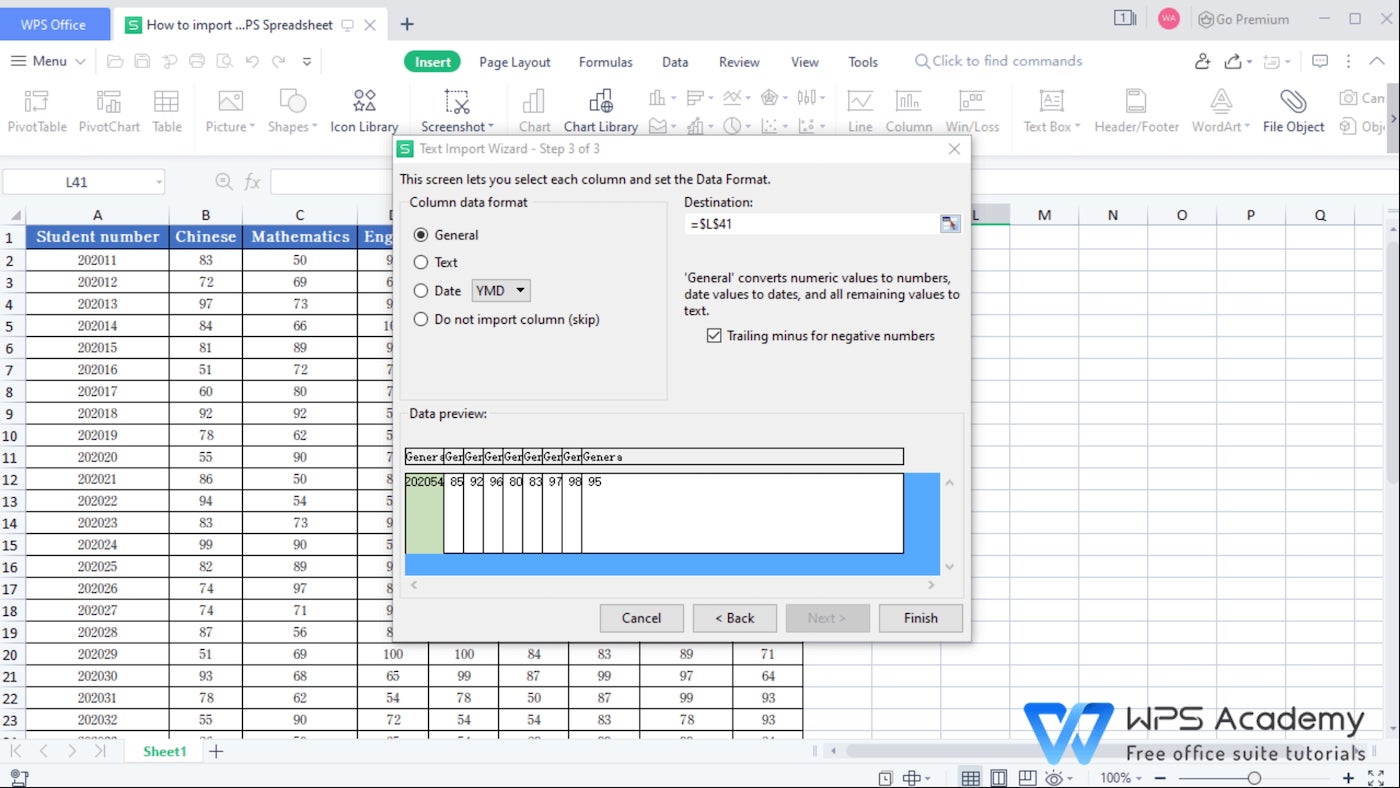 WPS Spreadsheet interface showing its text import wizard. Image: WPS Academy
WPS Spreadsheet interface showing its text import wizard. Image: WPS Academy
Pros and cons
ProsCons
- Offline access with full Excel-like features.
- Compatibility with office suites such as Microsoft Excel, Google Sheets, LibreOffice Calc, and OpenOffice Calc.
- Supports 13 languages on PC and 46 languages on mobile.
- Free version has ads.
- Frequently freezes.
- Advanced features like text recognition and AI spell checker are behind a paywall.
Smartsheet: Best for enterprise project and workflow management
![]() Image: Smartsheet
Image: Smartsheet
Overall rating: 4.41/5
Cost: 3.9/5
Core features: 5/5
Ease of use: 4.38/5
Support: 4.44/5
Expert score: 4.44/5
Smartsheet redefines what a spreadsheet can do by combining grid-based data entry with powerful project management tools like Gantt charts, resource tracking, automated alerts, and dashboards.
Built for enterprise teams, it enables seamless collaboration across departments and functions, supporting everything from marketing campaigns to IT deployments. Though not designed for complex mathematical modeling, Smartsheet excels at turning spreadsheet data into structured workflows and decision-ready reports, making it ideal for managing large-scale operations.
Why I chose Smartsheet
Smartsheet is quite different from Excel, to the point that it’s difficult to recommend them for the same use cases. But you can use both to keep track of business data such as sales or KPIs. I chose Smartsheet because it offers a lot of functionality and ease of use for free, even if it doesn’t do exactly what Excel can do.
It lets me combine data, timelines, and collaboration tools into one interface. I especially like its automated workflows and reporting features, which can help me keep stakeholders in the loop and projects moving forward.
Pricing
- Free: $0 for two editors or viewers, two sheets, 500MB attachments, 100 automations per month, dashboards and reports, and multiple views (grid, Gantt, calendar, and card).
- Pro: $9 per user per month, billed annually ($12 per user per month, billed monthly). This includes everything in the free plan, plus 250 automations per month, rich formulas, and unlimited viewers, sheets, forms, and reports.
- Business: $19 per user per month, billed annually ($24 per user per month, billed monthly). This includes everything in the Pro plan, plus 1TB of attachments, team workload tracking, timeline view, admin capabilities, and unlimited guests and automations.
- Enterprise: Contact the provider for a custom quote. This includes everything in the Business plan, plus work insights, unlimited attachment storage, directory integrations, and AI formulas, texts, and charts.
- Advanced Work Management: Contact the provider for a custom quote. This includes everything in the Enterprise plan, plus a dynamic view, calendar app, control center, and premium support.
Key features
- Create a dashboard by dragging and dropping widgets to track projects.
- Collaborate online.
- Integrate with Salesforce, Jira, DocuSign, Google, Box, or Dropbox.
 Smartsheet example interface for project management and collaboration. Image: Smartsheet
Smartsheet example interface for project management and collaboration. Image: Smartsheet
Pros and cons
ProsCons
- Versatile project planning and scheduling tools.
- Automated workflows can be applied to individual rows in the sheet to add conditions or specify how cells should relate to each other.
- Ability to set admin roles and lock certain cells.
- Lacks the analysis capabilities of Excel.
- Formulas work across columns, not in individual cells.
- Can be overwhelming for simple spreadsheet use.
More Microsoft news
Apple Numbers: Best Excel alternative for Apple device users
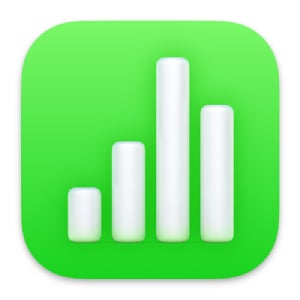 Image: Apple
Image: Apple
Overall rating: 4.4/5
Cost: 5/5
Core features: 4.2/5
Ease of use: 4.69/5
Support: 3.75/5
Expert score: 3.88/5
Apple Numbers is a free program like Excel that was developed by Apple as part of its iWork productivity suite. It’s available for iOS, iPadOS, and macOS and allows you to create and edit spreadsheets. Apple Numbers provides predesigned templates to help you get started quickly.
It offers various tools for organizing and analyzing data, including charts, graphs, and tables. You can also add text, images, and multimedia to your spreadsheets to create more engaging and informative documents.
Why I chose Apple Numbers
While I use Apple devices daily, I admit that I haven’t been converted to Apple Numbers since I’m most comfortable with Google Sheets. However, I was blown away by how simple it is to learn, navigate, and use.
It offers beautifully designed templates that I can use to make polished budgets, reports, and trackers. And its smooth integration with iCloud and other Apple apps makes file sharing with other Apple users seamless. I recommend it to Apple users who value design and simplicity over deep technical functionality.
Pricing
Apple Numbers is free to use and comes pre-installed on Mac, iPhone, and iPad devices. You can also download it for free from the Mac App Store or iOS App Store if your Apple device doesn’t have it. As long as you have a free Apple ID, you can use Numbers via iCloud.com on any browser and even on Windows PCs at no cost.
Key features
- It enables users to find trends with pivot tables.
- Users can highlight comparisons with radar charts.
- XLOOKUP functionality helps you find values in columns and rows or look for exact, approximate, or partial matches.
 Apple Numbers’ customized interface with charts and pivot options. Image: Apple Numbers
Apple Numbers’ customized interface with charts and pivot options. Image: Apple Numbers
Pros and cons
ProsCons
- Intuitive, simple, modern, and easy-to-use interface.
- Works offline.
- Real-time collaboration via iCloud.
- Limited to the Apple ecosystem.
- Lacks advanced formulas and data tools.
- Inconsistent compatibility with Excel files.
LibreOffice Calc: Best open-source spreadsheet with advanced formulas
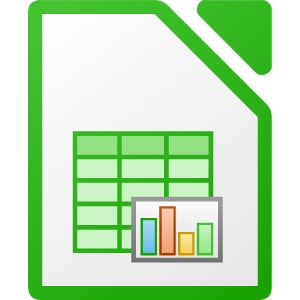 Image: LibreOffice
Image: LibreOffice
Overall rating: 4.1/5
Cost: 5/5
Core features: 4.13/5
Ease of use: 3.44/5
Support: 3.44/5
Expert score: 3.56/5
LibreOffice Calc is an open-source alternative to Microsoft Excel that offers a comprehensive suite of features for advanced spreadsheet users. It supports complex formulas, macros, pivot tables, and even scenario management, making it suitable for professional use in business and academic settings.
It’s a completely free desktop application with no ads or data tracking features. This makes it ideal for privacy-conscious users or organizations operating in Linux-based or offline environments.
Why I chose LibreOffice Calc
While I find LibreOffice Calc’s interface outdated and clunky, I would choose it if I needed a spreadsheet tool for serious data analysis. As is the case with most open-source software, LibreCalc comes with a decent learning curve because of its advanced features, which include formulas, macros, and pivot tables. However, it’s worth learning how to use it since it’s free, stable, and has strong cross-platform compatibility.
Pricing
LibreOffice Calc is free, open-source software (FOSS) that you can download, use, and distribute at no cost. You can also modify and share it with other users for free.
Key features
- Scenario manager that allows “what if …” analysis.
- Ability for users to export to .pdf.
- Desktop apps for Windows, macOS, and Linux.
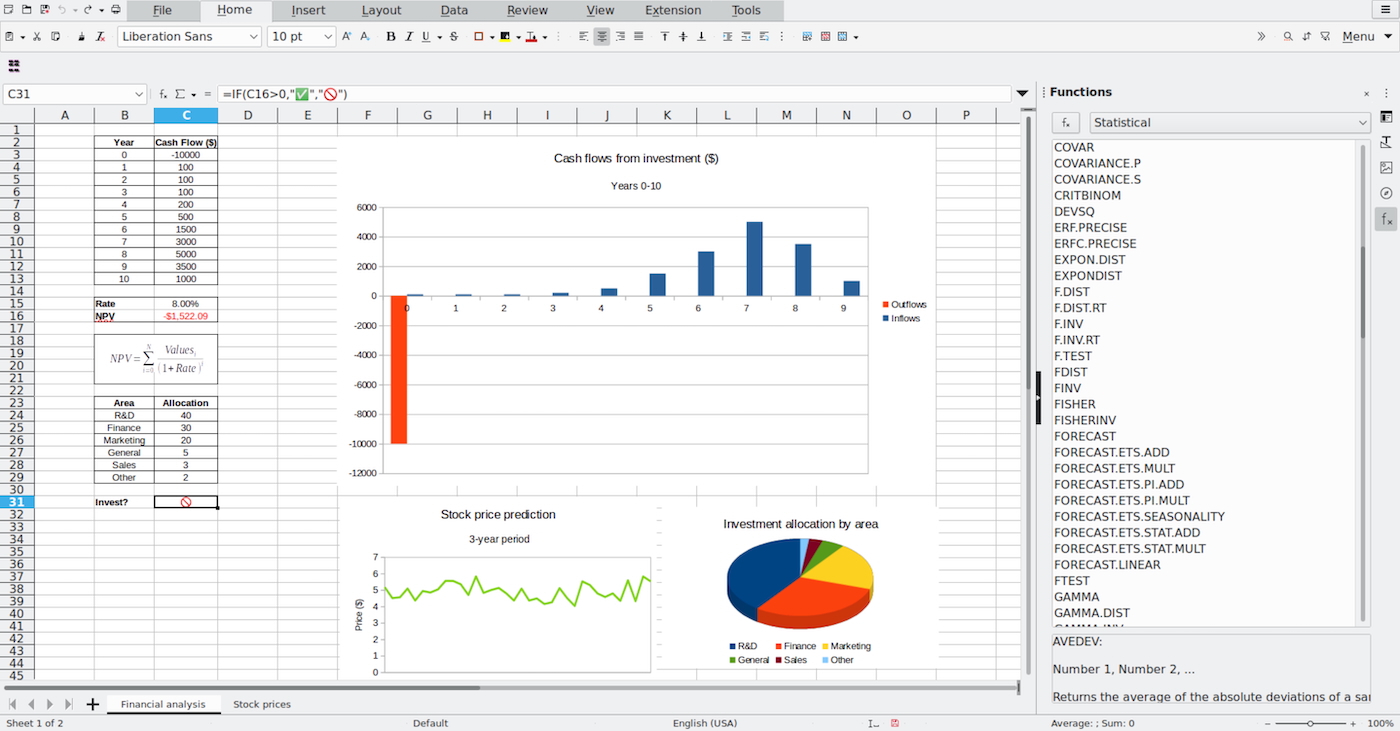 LibreOffice Calc interface with tables, charts, and functions. Image: LibreOffice
LibreOffice Calc interface with tables, charts, and functions. Image: LibreOffice
Pros and cons
ProsCons
- Free and open-source software.
- Ability to read .xlsx files created with Microsoft 365 for Windows and macOS.
- Offers powerful features like pivot tables and scenarios.
- Outdated and clunky user interface.
- No real-time collaboration.
- Lacks the ability to display many advanced types of charts.
AirTable: Best for no-code database management
 Image: Airtable
Image: Airtable
Overall rating: 4.08/5
Cost: 3.65/5
Core features: 4.22/5
Ease of use: 4.06/5
Support: 4.38/5
Expert score: 4.44/5
Airtable merges the simplicity of a spreadsheet with the structure of a database, offering a powerful no-code solution for teams managing content, inventory, CRM, or workflows. It allows users to link records, add file attachments, automate actions, and visualize data in grid, Kanban, Gantt, and calendar views.
While it’s not built for complex calculations, Airtable excels in organizing and tracking multi-dimensional data in a way that’s accessible to non-technical users, making it ideal for creative teams and startups.
Why I chose AirTable
I would choose AirTable if I needed something more dynamic than a regular spreadsheet to help me organize projects, link records, and track assets more visually. It hits the sweet spot between database functionality and spreadsheet familiarity, making it easy for me to start.
I love how I can export spreadsheets from Google Sheets or Excel to AirTable to transform the data into product timetables and customizable lists. Plus, I can easily switch between grid, calendar, and Kanban views, depending on what I’m managing.
Pricing
- Free: $0 for up to five editors. This includes an Interface Designer, unlimited bases, 1,000 records per base, 1GB of attachments per base, and 100 automation runs.
- Team: $20 per user per month, billed annually ($24 per user per month, billed monthly). This includes everything in the free plan, with 50,000 records per base, 20GB of attachments per base, 25,000 automation runs, and Gantt and timeline views.
- Business: $45 per user per month, billed annually ($54 per user per month, billed monthly). This includes everything in the Team plan, with 125,000 records per base, 100GB of attachments per base, 100,000 automation runs, and an admin panel.
- Enterprise Scale: Contact the provider for a custom quote. This includes everything in the Business plan, with 500,000 records per base, 1,000GB of attachments per base, 500,000 automation runs, and an Enterprise Hub.
Key features
- Airtable can help create apps based on your organization’s databases with an AI assistant.
- You can choose different workflow templates for whatever your organization needs to do.
- Users can visualize data in different views and formats.
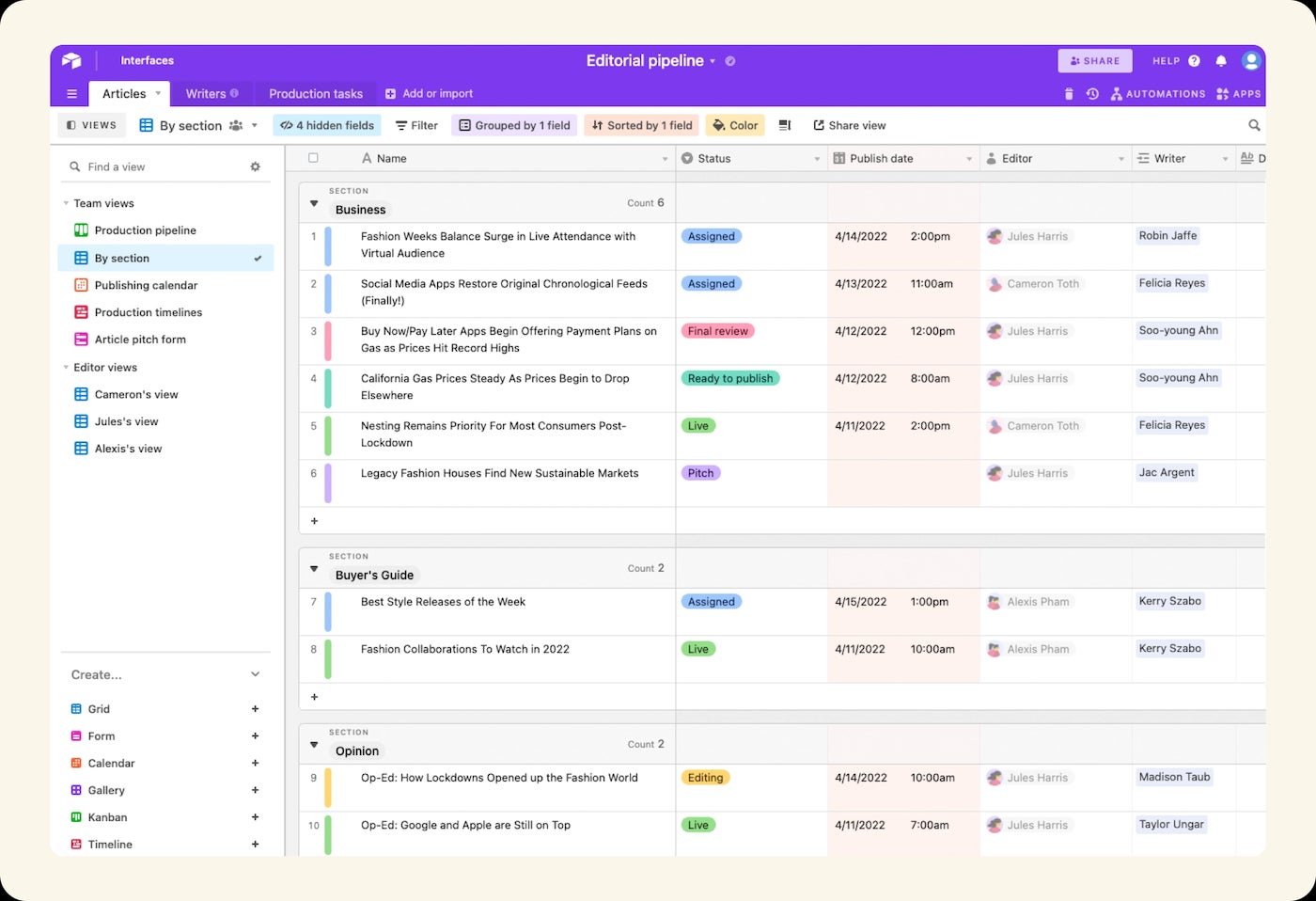 AirTable’s grid view features a series of rows, columns, and records. Image: AirTable
AirTable’s grid view features a series of rows, columns, and records. Image: AirTable
Pros and cons
ProsCons
- Cross-reference and correlate information with the database format.
- Simplicity makes it easy for non-technical users to build workflows and apps.
- Includes templates for CRM tools, applicant tracking, and other business use cases.
- Lacks some of Excel’s formula capabilities and advanced features.
- Doesn’t have Excel’s flexibility in linking or performing operations on individual cells as opposed to entire tables.
- Steep learning curve for traditional spreadsheet users.
Gnumeric: Best lightweight spreadsheet for Linux-based systems
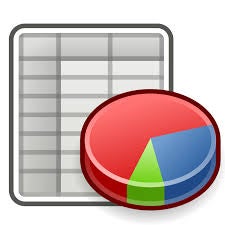 Image: Gnumeric
Image: Gnumeric
Overall rating: 4/5
Cost: 5/5
Core features: 2.8/5
Ease of use: 4.69/5
Support: 3.75/5
Expert score: 3.56/5
Gnumeric is a free and open-source spreadsheet program that’s fast, lightweight, and tailored for Linux users who need performance without the overhead. This tool, part of the GNOME office suite, offers precise numerical calculations, support for statistical functions, and compatibility with Excel file formats, all in a minimal, no-frills package.
While it lacks modern collaboration or cloud features, Gnumeric is ideal for users working on older or low-powered systems who need a quick, efficient tool for local data analysis and reporting.
Why I chose Gnumeric
I’m impressed with Gnumeric’s many features and functions, which include support for complex mathematical formulas, data analysis, tools, and advanced graphing capabilities. While the interface is utterly outdated, you can easily perform calculations, manipulate data, and create professional-looking charts and graphs with it.
Plus, it’s a lightweight and fast spreadsheet program that runs smoothly on Linux devices. It’s not fancy, but it gets the job done, especially when you don’t want unnecessary features slowing you down.
Pricing
Gnumeric is free and open-source, so you can download and use it without license fees, subscriptions, or paywalls. It is distributed under the GNU General Public License (GPL).
Key features
- Import and export support for the OpenDocument Format (ODF) and Office Open XML (OOXML).
- Capable of handling large datasets and complex calculations.
- It’s compatible with various file formats, including Microsoft Excel files and OpenDocument.
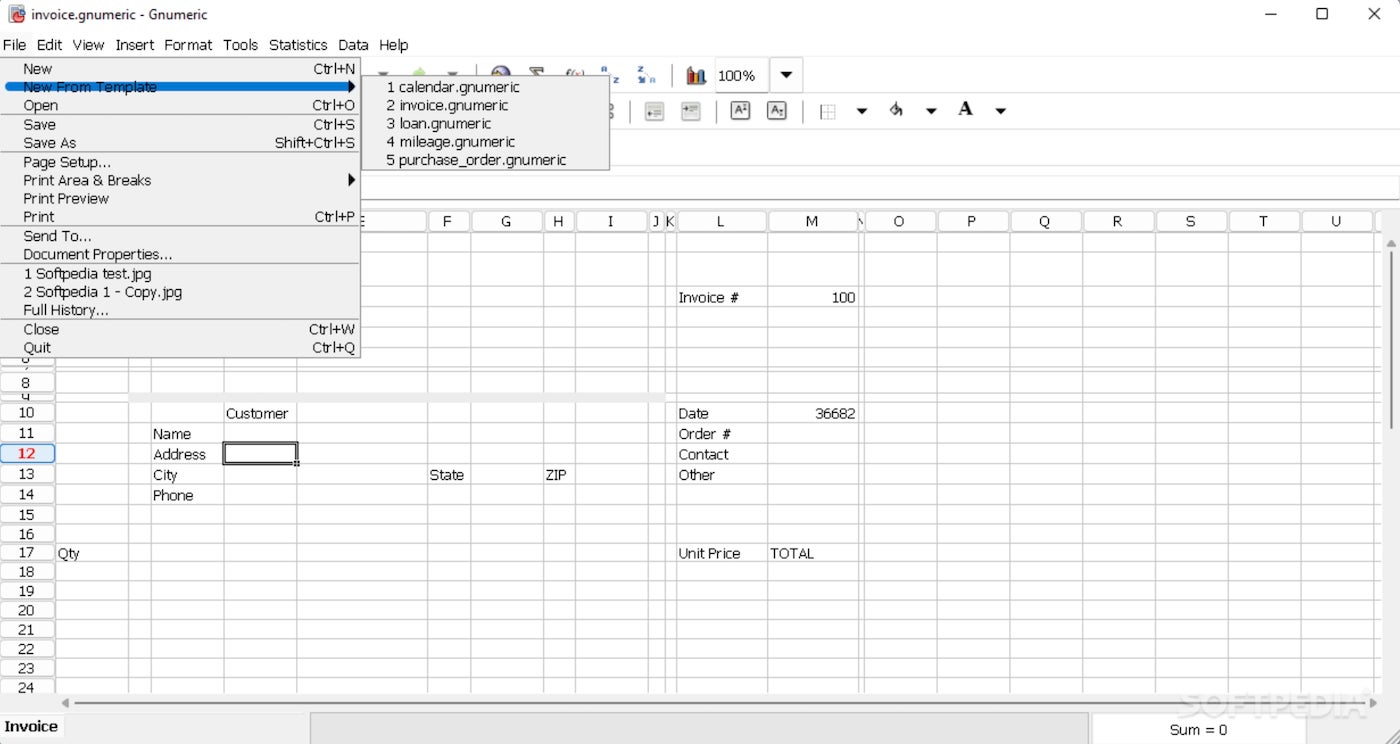 Gnumeric spreadsheet with template options. Image: Softpedia
Gnumeric spreadsheet with template options. Image: Softpedia
Pros and cons
ProsCons
- Handles large spreadsheets with ease.
- Gnumeric supports a wide range of file formats for importing and exporting data.
- Accurate for statistical analysis.
- Outdated and clunky interface.
- No collaboration or cloud features.
- No native support for Windows or Mac users without extra setup.
Apache OpenOffice Calc: Best for offline desktop users
 Image: Apache
Image: Apache
Overall rating: 3.92/5
Cost: 5/5
Core features: 3.21/5
Ease of use: 3.44/5
Support: 3.75/5
Expert score: 3.56/5
Apache OpenOffice Calc is a veteran spreadsheet solution ideal for users who need a reliable, offline tool that works across Windows, macOS, and Linux. It supports standard spreadsheet functions, charting, and formatting while offering broad compatibility with older Microsoft Excel files.
Though its interface feels dated and lacks real-time collaboration, Calc remains a trusted option for legacy environments and users who prioritize stability, file ownership, and long-term offline access.
Why I chose Apache OpenOffice Calc
Apache OpenOffice Calc is similar to Microsoft Excel and offers a range of features, including formulas, charts, and functions. It allows users to create and manipulate spreadsheets for tasks such as budgeting, financial analysis, and data organization.
I honestly don’t see myself using this spreadsheet for the long term, but I would if I needed a reliable and offline tool for managing older files and legacy formats. It’s free, cross-platform, and doesn’t tie me to any cloud service or subscription.
Pricing
Apache OpenOffice Calc is free to download, use, and share. There’s no subscription, license fee, or trial period. This program is released under the Apache License 2.0, which makes it open-source and legally free for both personal and commercial use.
Key features
- Natural language formulas allow users to create formulas using words.
- Ready-made templates repository.
- Scenario manager with support for “what if” analysis.
- Users can export documents in various formats, including .pdf, .odt, .doc, and .html.
 Apache OpenOffice Calc with a sample table, bar graph, and property settings. Image: OpenOffice
Apache OpenOffice Calc with a sample table, bar graph, and property settings. Image: OpenOffice
Pros and cons
ProsCons
- Completely free and open-source.
- Custom backgrounds enable users to create spreadsheets according to individual preferences.
- Works offline across all platforms.
- Lacks real-time online collaboration.
- Needs to be updated more frequently.
- Outdated interface and fewer modern features.
Reasons why you need Excel alternatives
While Microsoft Excel is a powerful tool, it’s not always the best fit for every user or team. Excel alternative programs often offer better collaboration, lower costs, and simpler interfaces, making them ideal for small businesses, students, and remote teams. Some alternatives also provide unique features like no-code automation, built-in task tracking, or real-time web-based editing.
Others are open-source and lightweight, ideal for Linux users or those who prefer privacy and offline work. Exploring alternatives is a smart move if you don’t need Excel’s advanced analytics or want a more modern or affordable solution.
SEE: New Excel features that will save you time.
What to look for in Excel alternatives
Choosing the right Excel alternative program depends on your goals, whether it’s better collaboration, automation, or ease of use. Before you make your decisions, I recommend considering and prioritizing these seven important features.
- File compatibility: Ensure it supports Excel file formats (.xls, .xlsx) without breaking formatting or formulas.
- Collaboration tools: Look for real-time editing, shared access controls, version history, and commenting features.
- Formula support: A robust library of functions and compatibility with common Excel formulas are essential.
- Visualization and analysis: Features like charts, pivot tables, filtering, and conditional formatting are useful for insights.
- Automation and extensions: Support for scripting (e.g., JavaScript, Python, or VBA equivalents) and third-party add-ons is a plus.
- Cross-platform access: Accessibility via web, desktop apps, and mobile platforms ensures flexibility.
- User interface and templates: A clean UI and pre-made templates can save time and reduce the learning curve.
Choosing a free Excel alternative
While all the tools outlined in this guide are noteworthy free Excel alternatives, the best option for you depends on your specific needs and preferences. If you need sheets you and your team can collaborate on seamlessly, choose Google Sheets. If you’d like to automate repetitive processes, Zoho may be your best option.
Those who want to customize their sheets and integrate them via API with their existing systems would benefit from Apache OpenOffice Calc. WPS Spreadsheet is ideal for individuals or companies that are more interested in usability, while LibreOffice is the best option for those looking for a feature-rich solution. If you’re a huge Microsoft Excel fan and only need cloud capability or prefer the desktop Excel interface, Microsoft 365 Excel Online is the best option.
To select the best option, consider your needs, select the top three tools that stand out to you, evaluate their features and capabilities, and choose the tool that fulfills your needs and use cases.
Methodology: How I evaluated the best free Excel alternative programs
To determine the best free Excel alternative programs, I compiled a list of popular spreadsheet software available for free. I assessed each alternative based on key criteria such as user interface, core features offered for free, compatibility with Excel files, collaboration tools, and customization options. I also considered factors like the starting price of paid plans, ease of use, expert score, and customer support.
Then, I tested each spreadsheet software by creating and editing sample spreadsheets, importing and exporting Excel files, and exploring advanced features such as macros and pivot tables. I gathered and analyzed user reviews and ratings from reputable sources to gain insights into the overall user satisfaction and feedback on each Excel alternative.
Here‘s a breakdown of my scoring criteria:
- Cost (30% of the total score)
- Core features (25% of the total score)
- Ease of use (15% of the total score)
- Customer support (15% of the total score)
- Expert score (15% of the total score)
Frequently asked questions (FAQs)
What is the best alternative to Excel?
The best alternative to Excel depends on your needs, but Google Sheets is widely considered the top choice for most users. It offers real-time collaboration, cloud access, and a familiar interface, all for free. Other strong options include Zoho Sheet for business users who need CRM integration and LibreOffice Calc for offline, as well as open-source spreadsheet functionality at no cost.
Is there a free version of Excel I can use?
Yes, Excel for the Web is a free, browser-based version of Microsoft Excel that offers basic functionality like editing, formatting, and sharing spreadsheets. It’s available with a free Microsoft account and is ideal for users who need light spreadsheet use without a desktop license.
Is there a Google spreadsheet like Excel?
Yes, Google Sheets is Google’s free spreadsheet application that closely mirrors Excel in functionality and layout. It supports many of the same formulas and tools, offers cloud storage, and excels in real-time collaboration, making it a strong choice for personal and business use.
Is Excel being phased out?
No, Excel is not being phased out. In fact, Microsoft continues to enhance Excel with new features like AI-driven insights, data automation, and integration with tools like Power BI. While cloud-based tools like Google Sheets have grown in popularity, Excel remains a staple in data analysis, finance, and enterprise reporting.
Which is the best free spreadsheet?
It’s hard to beat Google Sheets for ease of access, a wide range of features, and its ability to handle large amounts of data (up to 10 million cells). Here at TechRepublic, we use Google Sheets for content planning. Collaboration is easy and free.
Google Sheets is also especially effective for tracking business aspects such as cash flow, workflows, projects, and task statuses. This free spreadsheet’s color-coding feature highlights bottlenecks so that you can immediately address problem areas.
Plus, Google Sheets files are compatible with many other services, including Excel. You can also use Google Sheets to create tables and charts, so it’s the best of both worlds when it comes to spreadsheet and project management functionality.
Which free alternative is easiest for beginners?
Keeping in mind that ease of use can sometimes translate to simpler, less complex capabilities, Google Sheets is versatile and easy to use. Straightforward tutorials are available to walk users through creating tables and working with functions.
Ad

